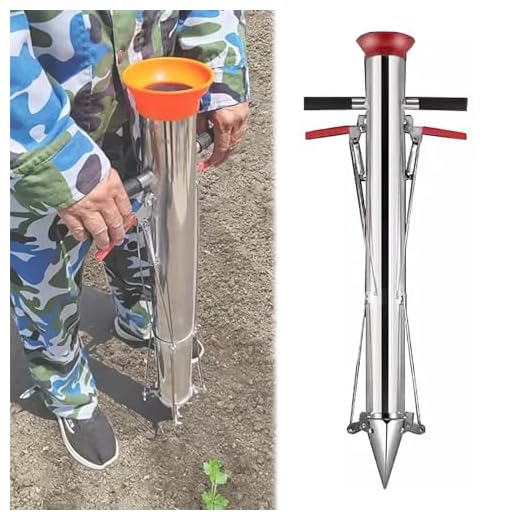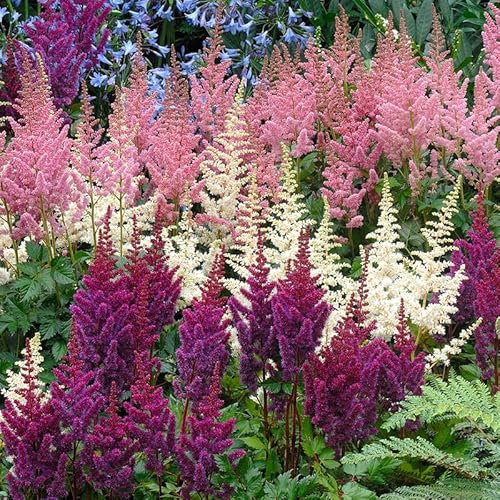




Planting flower bulbs can be a laborious task, especially if you are doing it by hand. Fortunately, there is a tool that can make the process much easier – a flower bulb planter. A flower bulb planter is a handy gardening tool designed specifically to create holes in the soil for planting flower bulbs.
Using a flower bulb planter is simple and efficient. First, choose the area where you want to plant your flower bulbs. It’s important to select a location with well-drained soil and that receives the appropriate amount of sunlight for the type of flowers you want to grow.
Once you have chosen the location, prepare the soil by removing any weeds or debris and loosening it with a garden fork or a trowel. This will ensure that the flower bulbs have a suitable environment to grow and develop. It’s also a good idea to add some organic matter, such as compost or peat moss, to improve the soil’s fertility and drainage.
Now it’s time to start using the flower bulb planter. Simply position the planter at the desired spot and push it into the soil. The sharp, cylindrical tip of the planter will create a hole in the ground. The depth of the hole will depend on the type of flower bulbs you are planting, so make sure to consult the packaging for specific instructions.
Once the hole is formed, place the flower bulb into the hole with the pointed side facing upward. Gently press the soil around the bulb to secure it in place. If you are planting multiple bulbs, make sure to space them according to the recommended guidelines to allow for proper growth and avoid overcrowding.
After planting all the flower bulbs, give the area a thorough watering to settle the soil and provide moisture to the bulbs. It’s important to keep the soil moist but not waterlogged, as this can cause the bulbs to rot. Regular watering, especially during the growing season, will help the bulbs thrive and produce beautiful flowers.
With a flower bulb planter, planting flower bulbs becomes a breeze. This tool saves you time and effort and ensures that each bulb is properly positioned in the soil for optimal growth. So, whether you are a seasoned gardener or a beginner, consider using a flower bulb planter to make the process of planting flower bulbs easier and more enjoyable.
Choosing the Right Flower Bulb Planter
When it comes to planting flower bulbs, having the right tools is essential. One of the most important tools you’ll need is a flower bulb planter. With so many options available on the market, it can be overwhelming to choose the right one. Here are some factors to consider when selecting a flower bulb planter.
| Factor | Description |
|---|---|
| Size | Consider the size of the flower bulbs you’ll be planting. A larger planter will be suitable for bigger bulbs, while a smaller planter is ideal for smaller bulbs. |
| Type | There are different types of flower bulb planters available, including manual and mechanical. Manual planters require more physical effort but offer more control, while mechanical planters are easier to use but may be less precise. |
| Depth | Check the depth range of the planter. Make sure it can reach the desired planting depth for the flower bulbs you have. |
| Handle | Consider the handle design of the planter. Look for a comfortable grip that allows for easy and efficient planting. |
| Material | Flower bulb planters are typically made from materials like stainless steel or plastic. Stainless steel planters are durable and long-lasting, while plastic planters are lightweight and easy to clean. |
| Price | Set a budget for your flower bulb planter. Prices can vary depending on the brand and features of the planter. Look for a planter that offers good value for money. |
By considering these factors, you’ll be able to choose the right flower bulb planter that meets your needs and makes the planting process a breeze.
Factors to Consider
When using a flower bulb planter, there are several factors that you should consider to ensure successful planting and growth of your bulbs.
1. Soil Quality
The quality of the soil is essential for the healthy growth of flower bulbs. Ensure that the soil is loose, well-draining, and rich in organic matter. Avoid compacted or clayey soils that can hinder root development and water drainage.
2. Sunlight Requirements
Before planting your bulbs, determine their sunlight requirements. Some bulbs require full sun, while others prefer partial shade. Choose a planting location that aligns with the specific needs of your bulbs to maximize their growth and flowering.
3. Planting Depth
The depth at which you plant the bulbs is critical. Different types of bulbs have varying planting depth requirements. Refer to the instructions provided with your flower bulb planter or consult a gardening guide to ensure that you plant the bulbs at the ideal depth for their specific species.
4. Watering Needs
Proper watering is essential for the successful establishment and growth of flower bulbs. Different species have varying water requirements, so be sure to water your bulbs accordingly. Generally, bulbs require regular watering, especially during dry periods, but excessive moisture should be avoided to prevent root rot.
5. Fertilization
Applying a balanced fertilizer at the time of planting can provide the necessary nutrients for your flower bulbs. Follow the recommended dosage and application instructions for the specific type of bulb you are planting. Avoid over-fertilization, as it can lead to excessive foliage growth and reduced flower production.
By considering these factors and taking appropriate actions, you can help ensure that your flower bulbs thrive and produce beautiful blooms.
Types of Flower Bulb Planters
When it comes to planting bulbs, having the right tools can make all the difference. There are several types of flower bulb planters available that are designed to help you easily plant bulbs in your garden or yard. Here are some of the most common types:
1. Handheld Bulb Planter
A handheld bulb planter is a convenient and easy-to-use tool that allows you to dig small holes in the ground to plant individual bulbs. It typically has a sharp, cylindrical metal blade at the bottom and a handle for easy gripping. You simply press the planter into the soil, twist it slightly, and lift it out to create a hole. This type of planter is great for small gardens or for planting bulbs in specific areas.
2. T-Handled Bulb Planter
A T-handled bulb planter is a larger version of the handheld bulb planter. It has a longer handle and a larger metal blade, allowing you to dig deeper holes and plant larger bulbs. This type of planter is ideal for planting bulbs in larger areas or for gardeners who prefer a more comfortable grip. The T-handle design provides better leverage and makes it easier to dig into the soil.
3. Auger Bulb Planter
An auger bulb planter is a drill-like tool that can be attached to a power drill. It has a spiral-shaped metal blade that spins when the drill is powered on. This type of planter is especially useful for planting large quantities of bulbs quickly and efficiently. The spinning blade digs deep holes in the soil, making it easy to drop the bulbs in and cover them up. It is a great option for those who have a lot of bulbs to plant or for professional gardeners.
When choosing a flower bulb planter, consider the size of your garden, the type of bulbs you will be planting, and your personal preference. Regardless of the type you choose, using a flower bulb planter will make the task of planting bulbs much easier and more efficient.
Preparing the Soil
Before using a flower bulb planter, it is important to prepare the soil to ensure optimal growth and blooming of your flowers. Follow these steps to properly prepare the soil:
1. Choose the right location
Select a location in your garden that receives ample sunlight and has well-draining soil. Most flower bulbs thrive in areas with at least 6 hours of direct sunlight per day.
2. Clear the area
Remove any weeds, rocks, or debris from the selected planting area. This will prevent them from competing with your flower bulbs for nutrients and water.
3. Loosen the soil
Using a garden spade or fork, loosen the soil to a depth of at least 12 inches. This will allow the flower bulbs to establish strong root systems and penetrate the soil easily.
4. Amend the soil
If your soil is heavy clay or sandy, improve its texture by adding organic matter such as compost or well-rotted manure. This will help retain moisture and nutrients for the flower bulbs.
5. Test the soil pH
Flower bulbs generally prefer a slightly acidic to neutral soil pH range of 6.0 to 7.0. Use a soil testing kit to determine the pH level of your soil and make any necessary adjustments by adding lime to raise the pH or sulfur to lower it.
6. Fertilize the soil
Before planting the flower bulbs, apply a balanced slow-release fertilizer according to the package instructions. This will provide the necessary nutrients for healthy bulb growth and flowering.
By following these steps and preparing the soil properly, you can create an ideal environment for your flower bulbs and enhance their overall growth and beauty.
Soil Type and Condition
When using a flower bulb planter, it is important to consider the type and condition of the soil in your garden or planting area. The success and health of your flowers depends greatly on the soil they are planted in.
Before using the bulb planter, it is advisable to assess the soil type and take steps to improve it if necessary. There are three main types of soil: sandy, loamy, and clay. Each soil type has its own characteristics and affects plant growth differently.
| Soil Type | Characteristics | How it Affects Plant Growth |
|---|---|---|
| Sandy | Large particles, drains quickly | Dries out quickly, poor nutrient retention |
| Loamy | Medium particles, well-balanced | Retains moisture and nutrients, suitable for most plants |
| Clay | Small particles, heavy and compact | Retains too much water, prone to waterlogged conditions |
Regardless of the soil type, it is important to ensure that the soil is well-draining. This can be achieved by adding organic matter, such as compost or well-rotted manure, to improve its structure. This will help prevent waterlogging and ensure that the bulbs have enough oxygen for healthy root development.
In addition to the soil type, the condition of the soil is also important. If the soil is compacted or has a lot of weeds, it may be necessary to aerate or weed the area before planting. This will create a better environment for the bulbs to establish and grow.
By taking the time to assess and improve the soil type and condition before using a flower bulb planter, you can greatly increase the chances of success for your flower bulbs. Healthy soil provides the necessary nutrients and moisture for optimal growth, resulting in beautiful and vibrant flowers.







